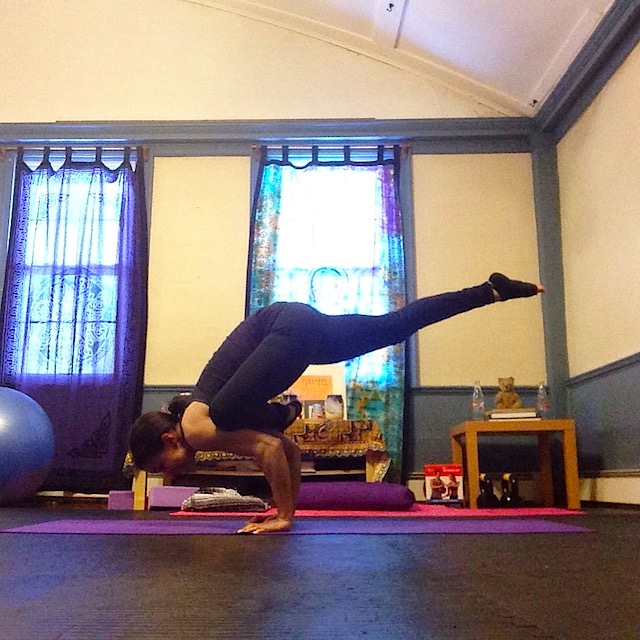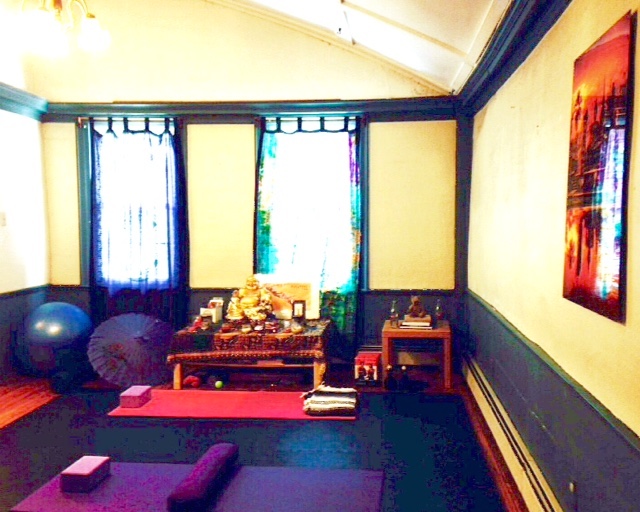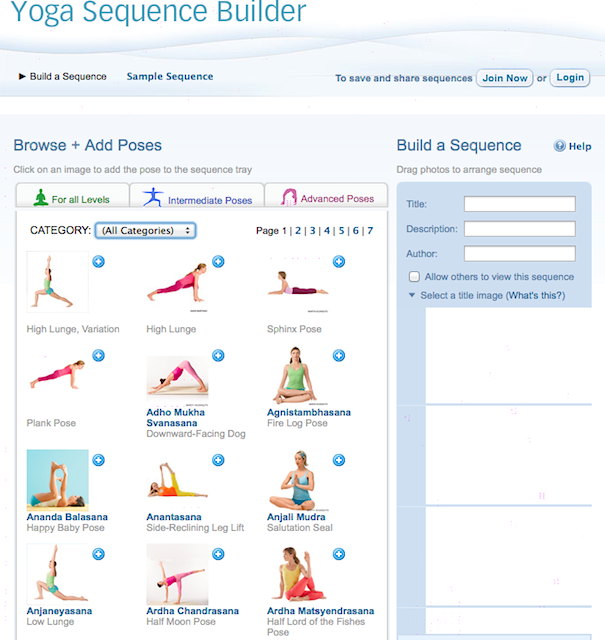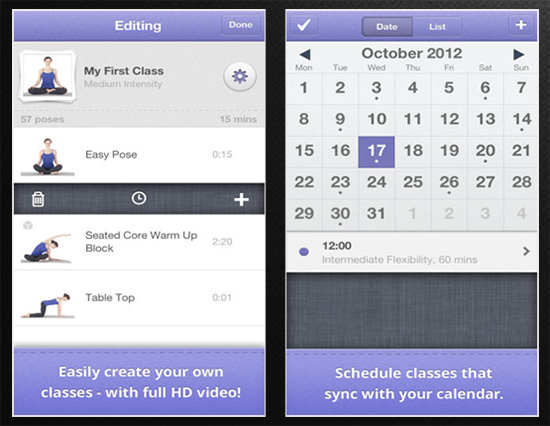 For the yogi looking for greater flexibility and independence in his or her workout, having a home yoga practice is immensely beneficial, providing a great opportunity to develop discipline, creativity and commitment to self. When you have your own yoga space in the home, whether it’s a room of your own or a designated area of a room where you can comfortably unfurl your mat, you have the power to orchestrate your own practice in a multitude of ways. You can do yoga in your most fashionable Lululemon apparel or in your pajamas. You have the freedom to decorate the space in a manner that complements and encourages your practice. If you want techno music to accompany your flow, you have the choice to pump your favorite music as loudly as you wish. You also have the opportunity to do yoga at your desired pace and intensity, whenever you want and for however long you prefer. While all of these things sound—and are—amazing, let me offer some tips from my own experience for developing a home yoga practice that is ideal for you.
For the yogi looking for greater flexibility and independence in his or her workout, having a home yoga practice is immensely beneficial, providing a great opportunity to develop discipline, creativity and commitment to self. When you have your own yoga space in the home, whether it’s a room of your own or a designated area of a room where you can comfortably unfurl your mat, you have the power to orchestrate your own practice in a multitude of ways. You can do yoga in your most fashionable Lululemon apparel or in your pajamas. You have the freedom to decorate the space in a manner that complements and encourages your practice. If you want techno music to accompany your flow, you have the choice to pump your favorite music as loudly as you wish. You also have the opportunity to do yoga at your desired pace and intensity, whenever you want and for however long you prefer. While all of these things sound—and are—amazing, let me offer some tips from my own experience for developing a home yoga practice that is ideal for you.
1. Creative a Conducive Mood and Tone For Your Practice
Your yoga space should be reflective of your personality and the intention of your practice. If you do restorative or yin yoga, you might be drawn to muted colors in your space, with soft and slow music (if any) and minimal decoration. If you’re attracted to more athletic yoga, like power yoga, you might want your space to be energizing, with bright colors and posters with positive affirmations or powerful quotes, exuberant music playing loudly while you’re on the mat.
 To clearly mark my yoga space, I decorated the area with a decidedly colorful, Asian theme. A golden Buddha statue sits atop patterned cloth from Nepal, behind a half dozen candles and in front of purple and aqua wall coverings, with hints of orangey yellow and grass green. The vibrantly colored wall coverings in the room are spiritually significant, featuring Om symbols, Ganesha and Buddha sitting in lotus. I have dark pink and purple yoga mats atop thick interlocking foam mats. My accessories include a purple bolster and yoga blocks. A decorate Japanese umbrella, also purple, sits in the corner.
To clearly mark my yoga space, I decorated the area with a decidedly colorful, Asian theme. A golden Buddha statue sits atop patterned cloth from Nepal, behind a half dozen candles and in front of purple and aqua wall coverings, with hints of orangey yellow and grass green. The vibrantly colored wall coverings in the room are spiritually significant, featuring Om symbols, Ganesha and Buddha sitting in lotus. I have dark pink and purple yoga mats atop thick interlocking foam mats. My accessories include a purple bolster and yoga blocks. A decorate Japanese umbrella, also purple, sits in the corner.
My use of the color purple is deliberate. Not only is it my favorite color, but it also symbolizes spirituality, creativity and the subconscious. One of the primary aims of yoga and meditation is to make the unconscious conscious. With stillness and focused attention, we bring subconscious thoughts and feelings into our full awareness. Subliminal thoughts and feelings, unresolved issues, fears, doubts and the memories of trauma reside in our subconscious (and also deep within the body), unconsciously affecting what we think and do and how we feel, both emotionally and physically. By bringing this shadow self of the subconscious into full awareness and clarity, we are better able to direct our thoughts and feelings, and thus our actions. We gain greater intuition and mastery over both the mind and body. I honestly can’t think of more inspiring symbolism to set the mood for my practice.
Feel free to use the power of aromatherapy by incorporating into your yoga practice essential oils that enhance the intention for your practice, whether it’s to strengthen, ground and center, or uplift. For instance, using lavender may provide calming and soothing effects, as well as serve as a remedy for insomnia. My favorite scents are vanilla and cinnamon. Vanilla is relaxing, calming and promotes clear breathing. Cinnamon helps reduce nervous tension and boosts attention and focus, while improving blood circulation and reducing inflammation and stiffness of the muscles and joints.
2. Set a Date With the Mat
While flexibility with timing is definitely a plus, I encourage you to schedule a specific time to do your yoga practice. Outside the home, you may take classes Monday, Wednesday and Friday from 5 p.m. to 6:15 p.m., or Tuesdays, Thursdays at Saturdays at 9 a.m. Setting aside regular class time inside the home should be no different.
When you rely on the whim of the moment to practice, you are much more likely to find excuses for why you can’t yoga: Your roommate or partner showed up early at home, and you don’t like having an audience. An unexpected weekday invitation that you don’t want to miss popped up, leaving no time to get in your yoga practice after work. You were offered a surprise work assignment during the time you really wanted to be doing yoga that day. Failing to make a firm commitment to your practice makes it easier for equally important tasks and responsibilities to take priority, pushing yoga further and further down on the to-do list.
Instead, find the times that work best for you at home, and firmly ink it into your schedule. Just as with classes outside of the home, you can set an ideal schedule and a backup schedule for when unavoidable conflicts interfere with your original practice time. You may also be flexible with the length of the sessions as you might find that doing yoga solo enables you to get through an entire session in less than an hour. Or you may find that being able to devote more time to each pose and flow inspires you to stretch out your time on the mat. Or you may enjoy breaking up your practice into multiple sessions a day, such as first thing in the morning and shortly before getting ready for bed at night. Enjoy your freedom, but commit to your practice.
3. Avoiding Yoga Shortcuts
“You must understand the whole of life, not just one little part of it. That is why you must read, that is why you must look at the skies, that is why you must sing and dance, and write poems and suffer and understand, for all that is life.” –J. Krishnamurti
 Having your own space to do yoga, you have the freedom to be your own conductor, with a bevy of ways to orchestrate your personal practice. Be careful not to cut yourself short by trying to take the “easy way” out of a complete practice. To prevent injury, don’t skimp on your warm-ups and cool downs. And don’t forget that yoga is more than just getting into asanas.
Having your own space to do yoga, you have the freedom to be your own conductor, with a bevy of ways to orchestrate your personal practice. Be careful not to cut yourself short by trying to take the “easy way” out of a complete practice. To prevent injury, don’t skimp on your warm-ups and cool downs. And don’t forget that yoga is more than just getting into asanas.
As fun and effortful as those multiple yoga challenges on Instagram are, for example, they should not be a replacement for a real, at-home practice. Consider doing challenge poses immediately after your practice, right before the cool down. It’s important to remember that simply doing a series of random poses in a row is not the equivalent of a comprehensive yoga sequence.
Transformative yoga sequences bring you safely from warm up to peak poses to cool down, incorporating breath work throughout. A sustainable yoga sequence is a seamless flow that safely and gradually builds off previous poses, allowing you to move with ease. Leave out any critical components, and you miss the point of practice.
You may compromise your breath. You may be misaligned. You may injure yourself. You may leave the mat more spastic than you were when you first stepped on it. Thus, you miss out on the long-term, holistic benefits of yoga. Why would you want to risk missing all of its best parts?
4. How to Stay Out of a Practice Rut
 Many new or intermediate yoga practitioners may get frustrated trying to create a home practice with limited knowledge or experience, doing the same, familiar sequence(s) over and over again. To keep your home practice motivating, you also want it to be fresh and fun. Don’t let a lack of expertise or creativity keep you stuck in a practice rut.
Many new or intermediate yoga practitioners may get frustrated trying to create a home practice with limited knowledge or experience, doing the same, familiar sequence(s) over and over again. To keep your home practice motivating, you also want it to be fresh and fun. Don’t let a lack of expertise or creativity keep you stuck in a practice rut.
From yoga classes to instructive articles and tools for designing your own yoga sequences, all you could ever need is literally right at your fingertips. There are numerous resources online that provide in-depth pose instruction and creative sequences that you can choose to include in your home practice. Yoga Journal offers a yoga sequence builder so you can arrange different poses in a sequence designed just for you. You can even design a dynamic and exciting sequence using poses from those Instagram challenges we love so much.
You can find classes and sequences, organized by difficulty, length, style and focus/theme at:
- DoYogaWithMe.Com—Free Online Yoga Videos
- GaiamTV My Yoga Online
- MyYogaWorks
- Powhow – Live Webcam Classes
- Yoga International
- Yoga Journal
- YogaGlo
- Yoga on YouTube
5. Don’t Wait Until You’re In the Mood
Perhaps you may recognize some of the thoughts that occasionally run through my mind when I know it’s time to step onto the yoga mat:
This morning is way too cold to do anything but bundle under a blanket.
Work was mentally and physically exhausting; all I want to do now is just vegetate.
I’m more in the mood to lift things or sing, cook or clean, run errands or really anything else but this!
While you may have legitimate reasons to postpone your practice, I recommend that you don’t wait until you’re in the mood or when conditions are “perfect.” Take some tips from the writer’s life. A writer must sit at the desk and show up on the page each day to be able to produce content. She can’t just wait for inspiration to make its magical appearance; she must regularly put in the work and take action in the right direction before that creative spark and passion can be ignited.
“Being in the mood to write, like being in the mood to make love, is a luxury that isn’t necessary in a long-term relationship. Just as the first caress can lead to a change of heart, the first sentence, however tentative and awkward, can lead to a desire to go just a little further.”― Julia Cameron, The Right to Write: An Invitation and Initiation into the Writing Life
Likewise, sometimes all it takes is getting into that first yoga pose to give you the momentum to keep going. I’ve often dragged my feet about starting yoga because I was in too much pain, too tired, too tense or had too much other work to do. Yet I know that in every instance I make the decision to get on the mat anyway, I find exactly what I need there. The time frequently gets away from me as I sink deeper into practice—if you have a tendency to overdo it, like I sometimes do, use a timer! But you need to step into your dedicated space consistently and completely in order to experience the myriad benefits of yoga.
[youtube https://www.youtube.com/watch?v=Goao_SzdHfs]
Each time I get on the mat, excuses fall away. I am relieved of pain, fatigue and stress; however long the effects last. My muscles lengthen and loosen, my joints become less stiff, and I become either more energized or more relaxed, depending on the intent of my practice at that time. My mind stops racing in a million directions thanks to my focused attention and controlled breath in the flow. Clarity and focus improves dramatically, freeing up the time it will take to do the work I need to attend to next. Every day, I take the opportunity to remember how yoga heals and restores me inside and out.
P.S. A Home Practice is Just One Piece of the Puzzle
A flourishing home practice is a great supplement to organized classes, though it should not completely replace guided or teacher-led classes. Having the support and guidance of a great teacher who can teach you new poses and properly correct your alignment is extremely valuable and necessary. You also have much to learn from fellow classmates, no matter their difficulty level. Having others to do yoga alongside also boosts motivation and accountability to your practice. Having the camaraderie and support of others through any type of exercise endeavor is truly a wonderful thing.

Nice information!